A fireplace is a natural companion for log homes and cabins. When we think of one, we picture a roaring fire with colorful flames that dance like fairies. A well-built fireplace unit can help keep the house warm, and those made with stone or brick masonry retain heat longer.
How Stone And Masonry Log Home Fireplaces Are Built
Stone and brick masonry fireplaces are typically built on an exterior wall with a poured concrete base under them for support. A firebox made of fire brick or a metal insert is constructed inside the fireplace for burning wood. Some fireplaces have a recirculating box with a fan to circulate the hot air into the room.
The chimney is made by stacking stone or brick with mortar between them to the correct height so the fireplace will draw correctly. It has a flue liner and a damper to control the amount of air coming in and to direct the smoke up the chimney. The fireplace and chimney must be constructed to conform to local building codes and insurance company requirements. Refer to safe operating procedures before using your fireplace.
Popular Stone And Brick Fireplace Fronts
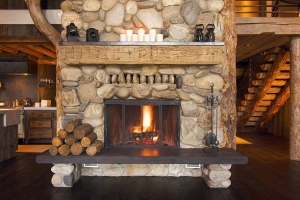 Fireplace fronts can be created with many different stone and brick designs. The most popular are stacked natural stone, flat stone, lodge-style, and center column.
Fireplace fronts can be created with many different stone and brick designs. The most popular are stacked natural stone, flat stone, lodge-style, and center column.
- Stacked Natural Stone – A fireplace made with varying shapes and sizes of stacked stones with mortar can spice up a log home and make the space more visually appealing and cozy. They can be full stones or stone veneer.
- Flat Stone – This style of fireplace is created with natural stones of various sizes or bricks that are cut flat on the tops and bottoms and stacked with mortar between them. It is also visually appealing and cozy.
- Lodge-Style – A lodge-style fireplace fills up a wall to the ceiling. It uses more stones or bricks but provides a dramatic effect. The stones or bricks can be of different shapes and sizes or uniform flat sizes.
- Center Column – A center column fireplace is not built in a wall. It stands alone generally in the middle of a room and reaches the ceiling. It can have one opening or openings on both sides of the column.
“A fireplace is a natural companion for log homes and cabins.”
Wood-Burning vs. Gas-Burning Log Home Fireplaces
Once you select the style and material for your fireplace, you can choose between burning wood and a gas. Each has its pros and cons to consider before you build the fireplace.
Wood-Burning
| Pros | Cons |
| More realistic flames | Must clean out ashes |
| Snap and crackle experience | More Work |
| Pleasant aroma | Can pose a safety hazard |
| Less cost with free firewood | |
| Provides more exercise |
Gas-Burning
| Pros | Cons |
| Easier to use and maintain | May leak gas into the room |
| More heat efficient | Less colorful flames |
| Flexible temperature control | Operating costs can be higher |
| More convenient | Lose heat rapidly when turned off |
Other things to consider are the operating costs and amount of work required to operate your fireplace. Propane gas costs more than natural gas and is generally available, whereas natural gas may not be. Obtaining firewood and operating a wood-burning fireplace is labor-intensive. Are you physically able to handle it and, can you obtain free firewood or will you need to buy it?
How To Increase Fireplace Heat Output
 Some of the heat generated by a fireplace is lost up the chimney. There are some ways to prevent this heat loss and increase the efficiency of heat output in a fireplace.
Some of the heat generated by a fireplace is lost up the chimney. There are some ways to prevent this heat loss and increase the efficiency of heat output in a fireplace.
- Install a fireplace insert
- Use a chimney damper
- Add an iron fireback
- Install fireplace doors
- Use a heat exchanger
- Install chimney fans
- Burn clean dry wood
- Regularly clean and inspect the fireplace
- Use a ceiling fan
Talk to your contractor before building your stone or masonry fireplace and chimney to determine which of the above components can be used for heating efficiency.
Add A Mantel Over Your Fireplace
Installing a wood mantel over your fireplace adds a charming addition to the room’s décor. The most cost-effective and appealing type is a pine half-log design. The best are kiln-dried to the correct moisture content for stability and staining. They have attractive dark knots and plenty of character in the wood. Mantels can be purchased with a pair of custom-scribed round log cradles for support. The popular sizes are 10” and 12” wide and 4’ to 6’ long and 7’ to 10’ long.
Fireplaces are natural additions to log homes, cabins, and cottages. Stone and masonry designs add a homey and rustic touch as well as heat your room. Enjoy yours this winter!


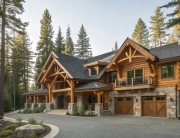
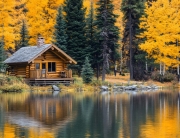
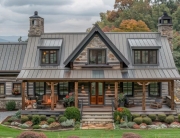
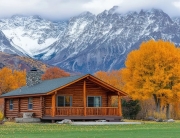

Recent Comments